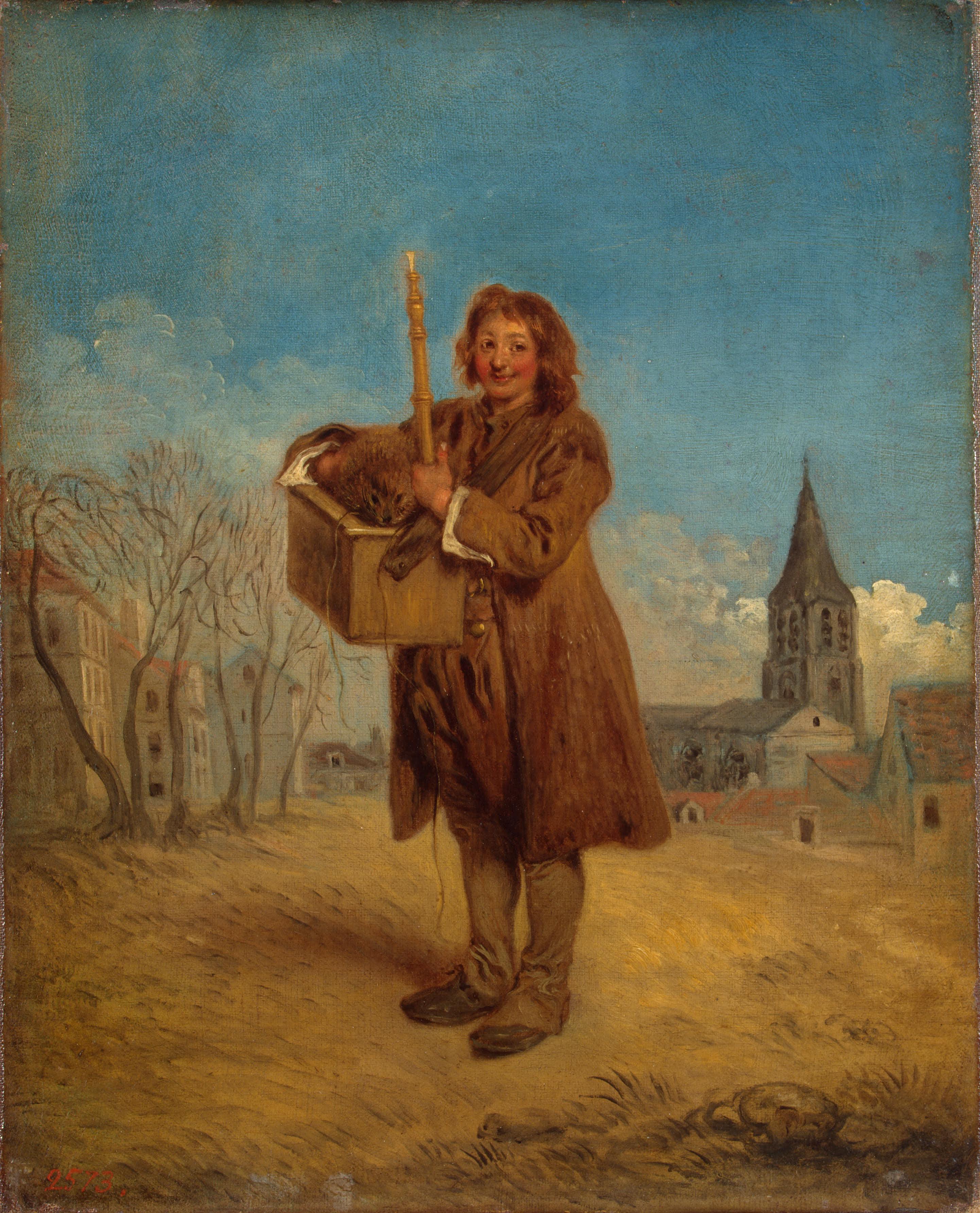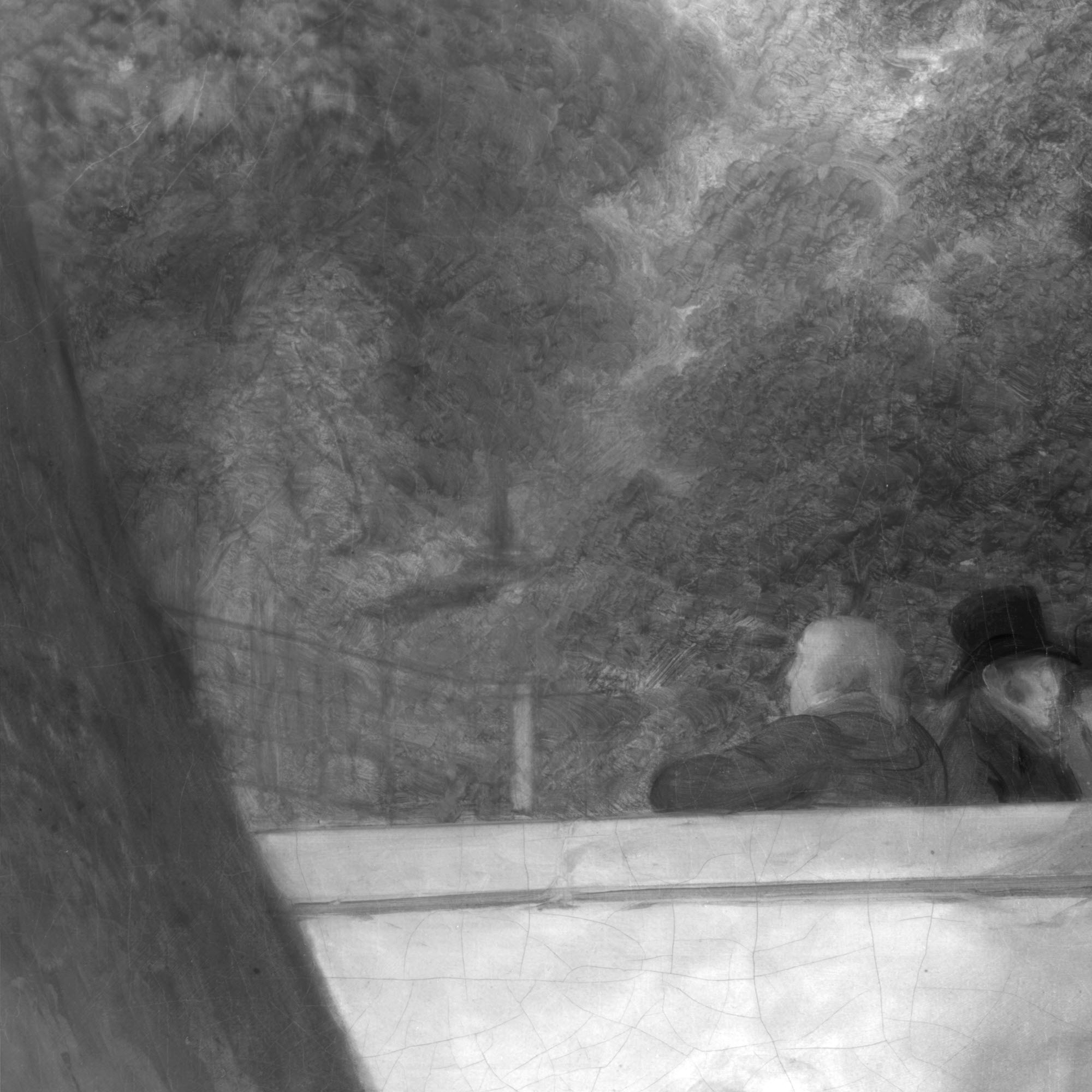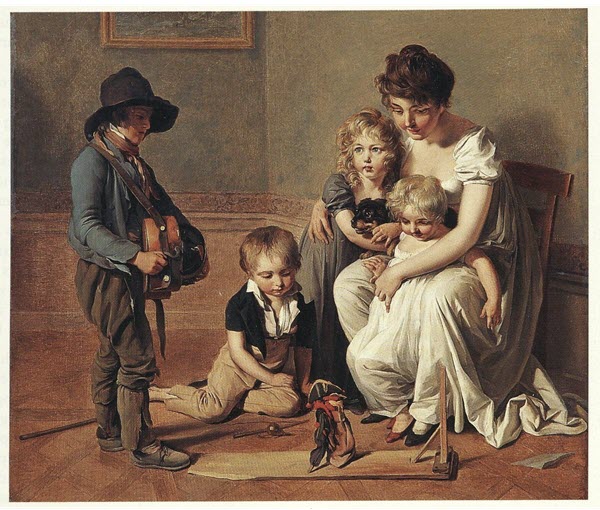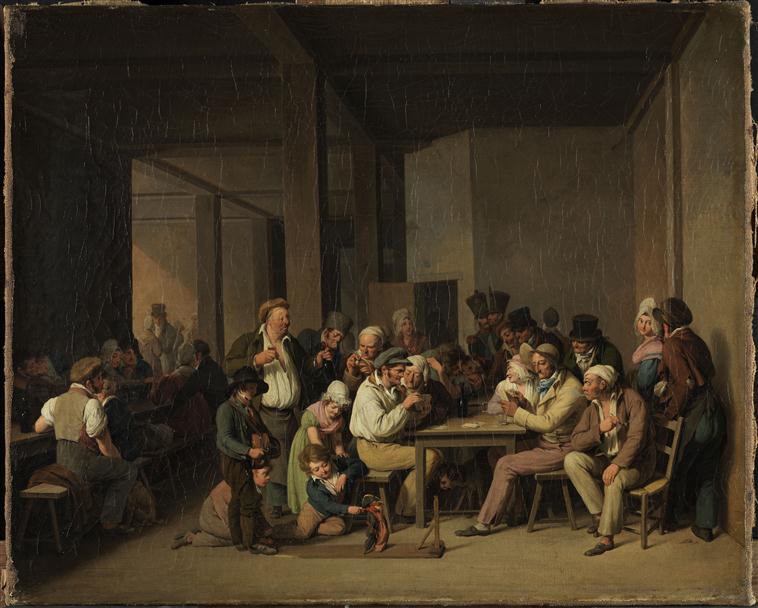Painted in a limpid Neoclassical style, Boilly’s picture transports us to the heart of Napoleonic Paris, where we stand outside the entrance to one of the city’s most celebrated cafés, the Jardin Turc. Café-goers crowd the doorway, spilling out onto the sun-dappled street and mingling with Parisians of every social condition, all engaged in the business and pleasure of modern leisure. Located in the Marais at 29, boulevard du Temple, the Jardin Turc offered its middle-class clientele delights once reserved for the aristocracy—culinary delicacies, a shady park, gaming tables, and musical entertainment.1 The establishment, founded in 1780, comprised an elegant garden, restaurant, and café housed in a series of tented pavilions whose crescent finials (visible at left) and orientalizing decor reflected an eighteenth-century taste for turquerie.2 Boilly captured the place at its apogee, one year after new management had converted the former ice cream parlor into a lavish dining room overseen by chefs who had worked in noble households before the Revolution.3 A wild commercial success, the Jardin Turc spawned numerous imitations and represented for many Parisians the democratization of luxury, rendering public formerly private pleasures.4
But in Boilly’s scene, we have not penetrated the exotic realm of the garden cafe, whose feathery treetops suggest a deep and tempting prospect at right. We have not passed through the crowded gate, over which an ornamental gilt “Turk” presides, cross-legged, at left. Instead, the artist has chosen to place us on the south side of the boulevard, directing our attention not so much to the scenery as to the spectacle of the crowded street outside the café. Young and old, fashionable and not, Boilly’s Parisians take evident delight in the novel social promiscuity permitted by the tree-lined boulevard, an eighteenth-century innovation that would come, over the course of the nineteenth century, to define the Parisian cityscape.5 The image conforms closely to contemporary prints representing the café’s thronged entrance (fig. 1), which served as a key landmark along the boulevard du Temple, the city’s new entertainment corridor.6 Featuring theaters, restaurants, and cafés, the street attracted large crowds, making it an early site for the modern pastime of people watching. Among the first truly public places in Paris where one went to see and be seen, the boulevard thus provided Boilly with the atmosphere of self-display and spectatorship that he took as his painting’s theme.

Ladies in stylish Empire-waisted gowns brush elbows with housemaids in their aprons, and men in gleaming beaver hats mix with street urchins. Class membership finds sartorial expression but always within the context of social harmony; this is a vision of Napoleonic Paris as a fashionable utopia. Two young boys, likely immigrants from the regions of Savoy (left) and Catalonia (right), furnish the afternoon’s principal entertainment.7 The Savoyard carries a wooden box tied around his neck, having taken from it a live marmot, whose bright eye and tiny paw Boilly rendered with economical finesse. The boy is a montreur de marmottes, a recognizable type of juvenile street performer in eighteenth- and early-nineteenth-century Paris; Watteau’s painting of a similar figure hangs in the Hermitage Museum (fig. 2). The sweet-faced montreur hands around his hat, hoping to make some money off the café’s chic customers, while to the right his partner entertains a group of children hardly younger than himself with music and a puppet show.8 Cranking a hurdy-gurdy with his right hand, the boy deftly dances two marionettes strung from his knee. His air of quiet concentration and the rapt enjoyment of his little audience give the vignette special poignancy.

Painted with the tender precision of a seventeenth-century Dutch fijnschilder, or “fine manner” painter, these figures nevertheless belonged to a contemporary cast of boulevard characters, of which the nineteenth-century viewer might count himself a part. “There is movement and truth in [Boilly’s] compositions,” wrote one Salon-goer in 1814; “one feels as though one recognizes his characters.”9 A more cynical contemporary observer remarked, “M. Boilly is blessed with the ability. . . to capture and caricature Parisian fashions and manners. His Jardin Turc attracts the crowd through this knack for truthfully tracing our absurdities; in it, each of us recognizes his neighbor.”10 Thus, for contemporary audiences, the painting might serve, like a stroll down the boulevard du Temple, as an exercise in visual recognition, a knowing game of exchanged glances.
As if to underscore the importance of sight and spectatorship, Boilly punctuated his composition with figures who, as Susan Siegfried has remarked, “by returning our gaze . . . seem to say they know we are staring at them.”11 From under the gate a bareheaded man looks back at us, and from the ticket window a young girl does the same; a lady in an elegant feathered bonnet at center turns smiling toward us, as does a widow to the right of the tree.12 Finally, at the rightmost edge of the canvas, Boilly himself, in spectacles and a top hat, looks steadily out of the picture plane in a small but penetrating self-portrait.13 At the time when he painted this picture, the artist resided in the rue Meslay,14 not ten minutes’ walk from the Jardin Turc, and thus his insertion of this portrait indicates his own membership in the neighborhood’s community of spectators.
Although born in 1761 into a modest northern French provincial family, Boilly had managed, by dint of painterly skill and commercial ingenuity, to establish himself as a comfortable Parisian bourgeois by the turn of the century. The son of a wood sculptor and minor art dealer, Boilly received his initial training from his father, Arnould, before leaving home for the larger town of Arras, where his study of trompe l’oeil technique instilled a lasting taste for exacting finish.15 At Arras, he set up shop as a portraitist and turned out an astonishing total of over three hundred small, highly finished portraits between 1778 and 1783. Having garnered a modest fortune and a considerable provincial reputation for the refinement and speed of his work, he moved to the capital in 1785.16 In Paris, Boilly painted precious genre scenes for a largely aristocratic clientele. These diminutive, jewel-like pictures reveal his debt to seventeenth-century Dutch and Flemish masters, whose work Boilly, like many of his French contemporaries, collected avidly.17 Sentimental and episodic, his pictures from this period also bear comparison to those of Jean-Baptiste Greuze and Jean-Honoré Fragonard and, like their work, often carry a mildly erotic, “gallant” subtext. These boudoir scenes met with considerable commercial success, if little official esteem; within the Académie Royale de Peinture’s hierarchy, such pictures ranked far below history paintings.
The Revolution brought radical changes to arts administration in France; the biennial Salon, where formerly only members of the Académie had been permitted to exhibit, was opened to all submissions in 1791—a momentous change for Boilly, who immediately recognized in these exhibitions a new platform for self-promotion.18 Threatened by the Jacobin Société républicaine des arts, which resented his aristocratic clientele and regarded as decadent his gallant subjects, Boilly painted his first large-scale street scene, a patriotic Triumph of Marat in 1794 (Lille, Palais des Beaux-Arts). The work served both to placate the revolutionary authorities and to demonstrate Boilly’s ability to produce pictures of greater ambition and scale.19 Although he would continue to paint small, private genre scenes throughout his career, from this point on, Boilly’s most important works concerned themselves with Parisian public life, or, perhaps more accurately, with Parisians’ private lives lived in the post-Revolutionary city’s new public spaces: its streets, parks, cafes, and theaters. A canny commercial strategist, Boilly capitalized on the marketing potential afforded by the Salon, which attracted crowds and press coverage. The large-scale, multifigure compositions he showed at the Salons enjoyed tremendous popular success and, even when they failed to sell, nonetheless helped attract clients for his smaller pictures on the private market.20 A famously swift and precise worker, Boilly increased his productivity and profits by recycling successful figures and groups from his Salon paintings in smaller cabinet pictures, harnessing a practice common among eighteenth-century genre painters to new entrepreneurial ends. A certain resulting repetitiveness in Boilly’s work—the family likeness of his sloe-eyed women, the recurrent figural groupings—sometimes attracted the sarcasm of Salon critics who dismissed his pictures as mere documents of contemporary fashion, works of imitation, rather than invention.21
In addition to the peril of monotony, Boilly’s recycling ran the risk of fragmentation when discreet compositional units failed to coalesce into a unified scene. Entrance to the Jardin Turc can be parsed into innumerable vignettes, several of which—the puppet show, for example (figs. 3 and 4)—resurface in other pictures by the artist.22 Close comparison of the painting with a recently discovered compositional drawing (fig. 5) demonstrates Boilly’s method of dropping readymade figures and groups into his scenes. The self-portrait at right, the seated man at center, and the standing woman in profile at left all seem to have been extracted, fully formed, from earlier works and inserted into the scene once Boilly had devised its overall structure.
Closer comparison of painting and drawing provides further insight into Boilly’s working methods.23 Whereas the finished picture describes the facade with evident fidelity, the drawing treats the architecture in summary fashion, indicating the café’s name above the door, along with its street address24 and its offer of “Déjeuneur—chaud et froid.” There are noticeable changes of pose: the marmot, for example, migrates from its box in the drawing to the arms of the Savoyard in the painting. There are also substitutions: the young girls beside the tree do not figure in the drawing; the toy horse visible behind the puppeteer in the drawing becomes a dog in the picture; and an old woman at the center of the drawing is replaced in the painting by a man borrowed from another composition.25 There are also important additions: neither the little girl with the bunch of grapes at the center right of the picture nor the woman in a lace bonnet seated beside her husband at right appears in the drawing. Nonetheless, the passage that most clearly indicates the relationship between drawing and painting involves a waiter, who appears in the upper right background of the drawing, carrying a tray on the café terrace. An infrared scan of the painting (fig. 6) reveals that Boilly originally included the figure before changing his mind and covering him with foliage. This subtle modification signals a larger reconfiguration that turned the focus of the finished painting away from the interior activity of the café itself and toward the boulevard instead.

What prevents the picture—despite Boilly’s habit of swapping motifs in and out—from disintegrating into a series of disconnected episodes—what makes the whole more than a sum of its parts—is Boilly’s mastery of light. Washing down from an indeterminate source at the upper left, afternoon sunlight gently bathes the crowd in its radiance. The effect is almost theatrical, transforming the boulevard into a brightly lit proscenium stage; Boilly’s Parisians become actors, playing their roles in a carefully stage-managed production. It is this element of theatricality, of harmoniously orchestrated artifice that sets Boilly’s rendering of modern street life apart from the project of Charles Baudelaire’s “Painter of Modern Life.” As a precocious flâneur, a connoisseur of the boulevard, Boilly anticipated the Impressionists by over half a century, but his supreme control—in his arrangement of figures, his orchestration of lighting effects, and, most of all, his immaculate painted surface—connects his work to an older tradition. Like the figure of the little Savoyard, a marmot nestled in the crook of his arm, Entrance to the Jardin Turc harks back to the seventeenth and eighteenth centuries. The picture remains suspended somewhere between the fairgrounds of David Teniers and Édouard Manet’s Music in the Tuileries—an image of contemporary sociability that can be classified as neither a picturesque fantasy nor a deadpan report.
- Emily A. Beeny
Appendix
Related Studies and Drawings:
- Compositional Study for the Entrance to the Jardin Turc. Pen and ink on paper, 28 x 38 cm (Los Angeles, J. Paul Getty Museum, 2011.22): this drawing, with few alterations, outlines the picture’s composition.
- Profile of a Young Woman’s Head. Oil on paper on canvas, 25.7 x 22.2 cm (Los Angeles County Museum of Art, inv. M.2000.179.33): this sketch, likely a portrait of Boilly’s first wife, lends her profile to the standing lady in white on the left.
- Portrait Study of Jean Duplessi-Bertaux. Oil on paper laid down on canvas, 17.6 x 15.4 cm (Lille, Palais des Beaux-Arts, inv. 366): originally made in preparation for the 1798 group portrait A Gathering of Artists at Isabey’s Studio, this study of the artist Duplessi-Bertaux reappears in the figure of a seated man at center.
- Study of a Little Boy. Oil on canvas, 31 x 18 cm (location unknown): this figure becomes the standing child who observes the marmot at center.
- Study of a Boy and a Girl. Oil on canvas, dimensions unknown (private collection): these standing figures appear to the right of the puppet show group.
- Study of Children with a Marionette. Sepia wash on paper, 14 x 19 cm (location unknown): this study, reversed, furnished the motif of the hurdy-gurdy player and audience.
- Study of a Young Savoyard, a Man, and a Seated Woman. Oil on canvas, 46 x 33 cm (Richmond, Virginia Museum of Fine Arts, collection of Mr. and Mrs. Paul Mellon): this group appears at left in the painting.
- Study of a Leaning Woman. Oil on canvas, 21 x 15 cm (location unknown): this figure is used for the woman with a red shawl watching the puppet show.
- Study of a Little Hurdy-Gurdy Player. Black chalk and gray wash on buff paper, 13 x 18.9 cm (private collection): this sketch includes a finished drawing of the hurdy-gurdy player with the boy and dog beside him added in outline.
- Study of the Facade of the Jardin Turc. Drawing, dimensions unknown (London, private collection): this sketch was certainly made in preparation for the painting.
- Study of a Dog. Pastel on paper, 22.3 x 29.4 cm (Dijon, Musée national Magnin, inv. 1938 DF 468): this dog appears in the arms of a child watching the puppet show at center.
Related Finished Paintings:
- A Gathering of Artists at Isabey’s Studio, 1798. Oil on canvas, 71 x 111 cm (Paris, Musée du Louvre, inv. 1290 bis): this picture shares with Entrance to the Jardin Turc the seated figure of Jean Duplessi-Bertaux.
- A Family Party, 1803. Oil on canvas, 33 x 27 cm (Boulogne-sur-Mer, Musée du château, inv. 35 L): this picture includes the profile of Mme Boilly reproduced in Entrance to the Jardin Turc.
- Young Savoyards Showing a Marmot, 1807. Oil on panel, 23.5 x 32 cm (location unknown): this picture includes the same montreur de marmottes.
- L’Entreé du Jardin Turc (ricordo), 1812. Watercolor, dimensions unknown (location unknown): following contemporary practice, Boilly often made scaled-down ricordi of his large Salon compositions.
- Tavern Scene, ca. 1815. Oil on canvas, 37 x 47 cm (Paris, Musée du Louvre, inv. RF1936): this picture includes the same marionette performer.
- The Marionette Performance. Oil on paper, 41 x 47 cm (Paris, Kugel collection): this picture includes the same puppet show group.
-
On the Jardin Turc, its decor and history, see Robert Courtine, La vie parisienne, vol. 1, Cafés et restaurants des boulevards, 1814–1914 (Paris: Perrin, 1984), pp. 18–20; Bernard Rouleau, Villages et faubourgs de l’ancien Paris (Paris: Seuil, 1985), pp. 107–15; Victor Fournel, Le vieux Paris: Fêtes, jeux et spectacles (Paris: Alfred Mame et fils, 1887), pp. 127, 139, 142, and 147; François Fosca, Histoire des cafés de Paris (Paris: Firmin-Didot, 1934), pp. 86–87, 89, and 101; Béatrice Malki-Thouvenel, Cabarets, cafés et bistros de Paris (Le Coteau: Horvath, 1987), pp. 115–18. ↩︎
-
On the significance of turquerie, the taste for and imitation of Turkish visual culture in eighteenth-century France, see Perrin Stein, “Exoticism as Metaphor: ‘Turquerie’ in Eighteenth-Century French Art” (Ph.D. diss., New York University, 1997). ↩︎
-
Courtine 1984 (note 1), pp. 19–20. ↩︎
-
Susan Siegfried discusses a parallel and inverse phenomenon, the “domestication” of the Parisian boulevard in the context of Boilly’s painting in The Art of Louis-Léopold Boilly: Modern Life in Napoleonic France, exh. cat. (New Haven: Yale University Press with the Kimbell Art Museum and the National Gallery of Art, 1995), p. 133. My interpretation of the picture throughout this entry is indebted to Siegfried’s analysis. ↩︎
-
Honoré de Balzac’s “Histoire et physiologie des boulevards de Paris” (1830) provides an illuminating survey of this new urban landscape. See Traité de la vie élégante. Physiologie du rentier de Paris. Physiologie de l’employé. Les Boulevards de Paris (Paris: Bibliopolis, 1911), pp. 219–38. ↩︎
-
On the boulevard du Temple, also known as the “boulevard du Crime,” see Fournel (note 1), pp. 118–33. ↩︎
-
The boy at left conforms to eighteenth-century representations of Savoyards. See, for example François-Hubert Drouais’s The Comte and Chevalier de Choiseul as Savoyards, 1758, oil on canvas, 39 x 107 cm (New York, The Frick Collection, 1966.1.164). Fournel identified a similar hurdy-gurdy-playing puppeteer in a contemporary Garnier print as a Catalan (p. 128), although another disguised portrait by Drouais suggests that the hurdy-gurdy also belonged to standard Savoyard iconography: Les enfants du duc de Bouillon, 1756, oil on canvas, 86 x 130 cm (private collection). My thanks to David Pullins for bringing these works to my attention. ↩︎
-
Some authors have asserted that several of the children represented in this group may have been Boilly’s own daughters and his younger son, Adolphe. The woman in a white cap, who seems to be a nurse or housemaid, may have been modeled by Boilly’s second wife. See André Mabille de Poncheville, Boilly (Paris, 1931), p. 124, and Marianne Delafond, ed., Louis Boilly, 1761–1845, exh. cat. (Paris: Musée Marmottan, 1984), p. 51. ↩︎
-
Charles-Paul Landon, Annales du musée et de l’école moderne de beaux-arts: Salon de 1814 (Paris: C. P. Landon, 1814), p. 99: “il y a du movement et de la vérité dans ses compositions, et l’on croit reconnaitre ses personages.” ↩︎
-
André Castellan, in Le moniteur universel, March 10, 1813: “M. Boilly est doué de la faculté d’exécuter avec prestesse et de saisir la caricature des modes et des tournures parisiennes. Son entrée du Jardin turc attire la foule par cet art de retracer avec vérité nos ridicules; chacun y reconnait son voisin.” Quoted in Paul Marmottan, Le peintre Louis Boilly (1761–1845) (Paris: H. Gateau, 1913), p. 132. ↩︎
-
Siegfried 1995 (note 4), p. 143. ↩︎
-
This figure, too, has been associated with Boilly’s second wife. See Richard Beresford and Peter Raissis, The James Fairfax Collection, exh. cat. (Sydney: Art Gallery of New South Wales, 2003), p. 34. ↩︎
-
Boilly’s likeness is known from identified self-portraits in a number of other works, including A Gathering of Artists in Isabey’s Studio, 1798, oil on canvas, 71 x 110 cm (Paris, Musée du Louvre, inv. 1290 bis); Laughing Man, ca. 1820, black, red, and white chalk on paper, 23 x 17.5 cm (Boston, Museum of Fine Arts, inv. 65.2536); and the image closest to his portrait in the Jardin Turc, the self-portrait at Versailles in the Musée national du château (oil on canvas, 45 x 38 cm, inv. MV7076). ↩︎
-
A splendid trompe l’oeil tabletop at the Palais des Beaux-Arts, Lille (inv. Pl. 1896) represents a subscription ticket that gives Boilly’s address as “rue Meslée 12.” ↩︎
-
Under Dominique Doncre, beginning in 1778. Boilly had received additional training from an Augustinian prior in Douai before settling in Arras. ↩︎
-
The details of Boilly’s early biography are known chiefly through a surviving autobiographical manuscript, written with the aid of his son Julien and preserved at the Bibliothèque historique de la ville de Paris. On this document, see Michel N. Bénisovitch, “Une autobiographie du peintre Louis Boilly,” in Essays in Honor of Hans Tietze, ed. Ernst Gombrich (New York: Gazette des Beaux-Arts, 1958), pp. 365–72. ↩︎
-
Boilly’s collection was dispersed in a sale at the rooms of Bonnefons de Lavialle on April 13–14, 1829. The catalogue lists works by Gerrit Dou and Willem van Mieris, among others. On Boilly’s collection and the influence of Dutch fijnschilderen on his style, see Carol S. Eliel, “Genre Painting during the Revolution and the Goût Hollandais” in Alan Wintermute, ed., 1789: French Art during the Revolution, exh. cat. (New York: Colnaghi, 1989), pp. 47–59, esp. pp. 51–53. ↩︎
-
On these administrative changes, see Jean-François Heim, Claire Béraud, and Philippe Heim, Les Salons de peinture de la Révolution française, 1789–1799 (Paris: C.A.C s.a.r.l1., 1989), pp. 37–43. ↩︎
-
On the Concours de l’an II, the occasion for which Boilly painted this picture, see William Olander, “French Painting and Politics in 1794: The Great Concours de l’an II” in Wintermute 1989 (note 17), pp. 29–45, esp. p. 31. ↩︎
-
Siegfried outlines this strategy, Siegfried 1995 (note 4), pp. 133–34. ↩︎
-
Of Entrance to the Jardin Turc, for example, Pierre-Marie Gault de Saint-Germain wrote in “Observations sur l’état des arts au XIXème siècle dans le Salon de 1814,” in Le Spectateur, ou Variétés historiques, littéraires, critiques, poétiques et morales, vol. 3 (1814), p. 111: “Drawn from the manners of society, his characters and compositions form brilliant pictures . . . but the eye grows weary of their monotony, and reputations weaken with time when established only on the habits and inclinations of a generation” (“Ses compositions, ses caractères, puisés dans les moeurs de la société, forment des tableaux brillans . . . Les yeux se lassent de la monotonie, et les réputations foiblissent avec le temps, lorsqu’elles ne sont établies que sur le penchant et les habitudes d’une generation”). ↩︎
-
Siegfried discusses the problem in relation to this painting, p. 146. For a list of known works preparatory for or related to this painting, see appendix herein. ↩︎
-
On this relationship, see Boilly (1761–1845), Annie Scottez de Wambrechies and Florence Raymond, eds., exh. cat., (Lille: Palais des Beaux-Arts, 2011), pp. 203–4, nos. 136–37, entry by Emily Beeny. ↩︎
-
The number “31” is incorrect. The café’s address was in fact no. 28. It is omitted in the finished picture. ↩︎
-
He repeats the portrait of Jean Duplessi-Bertaux in A Gathering of Artists at Isabey’s Studio (Paris, Musée du Louvre, inv. 1290 bis). See appendix. ↩︎


